
Medals were an integral feature of friendly societies from the time of their formation. In the AOF the General Laws of the Order referred to them right from the beginning. ‘Should any brother render to his Court, or the Order in general, essential service, it is recommended as a stimulus to further exertions, that he be rewarded in such a manner s the court to which he belongs thinks proper by a silver medal.’ Past Chief Rangers, Secretaries and Treasurers were also singled out as potential recipients.
The first Forester to receive a medal was Bro. Joseph Lancaster of Bradford, Yorkshire, ‘for the truly admirable and temperate manner’ in which he conducted the business of the convened meeting of delegates at Rochdale, Lancashire in August 1834 when the AOF was created.
What’s special about OUR collection of AOF jewels/medals?
| > | Many of the items can be associated with a particular member, providing a personal and intimate link with the past; |
| > | Our medals and jewels have the potential to enable definitive chronological and typological displays of AOF items to be established. |
Subject Headings Banners |
Further Reading Discovering Friendly and Fraternal Societies, Victoria Solt-Dennis (2005) The Ancient Order of Foresters Friendly Society - 150 Years, Walter Cooper (1984) |
 |
 |
 |
 |
 |
 |
 |
 |
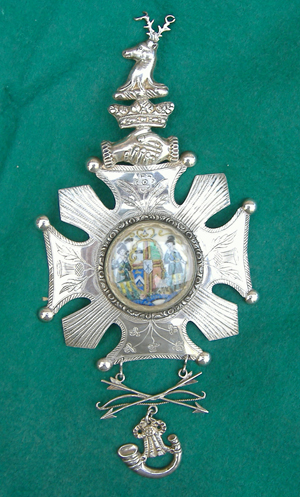 |
Silver Medal 1841 This silver AOF medal which comes from a private collection, is one of the earliest known of such good quality. The central insert is marvellously executed in hand colouring and with a diameter of 1.5ins (4cms) the detail of the coat of arms is perfectly clear. On the back is an inscription, beautifully engraved reading, around the perimeter ‘ COURT METROPOLIS OF THE ANCIENT ORDER OF FORESTERS N0.713 June 28th/41.’ The Court number shpould be 715 and in full the year was 1841. In the centre is the following engraving. ‘Presented to Br James Bimson PCR of the above Court, for his Good and Meritorious Services in the above Court.’ The medal is hallmarked, but the maker ‘MS’ has not yet been identified. Court “Metropolis” was the first Foresters Court to be founded in Surrey, in 1838, although within a couple of years members were meeting on the northern side of the Thames, over Vauxhall Bridge, in Pimlico, Middlesex. The Court subsequently moved home location on several occasions, to both north and south of the Thames. In the early 1920's it amalgamated with another Court. James Bimson, a carpenter at the time he received the medal, went on to become a coachbuilder with a business in Lambeth. He died in 1894. |
|
| Back to Top | ||
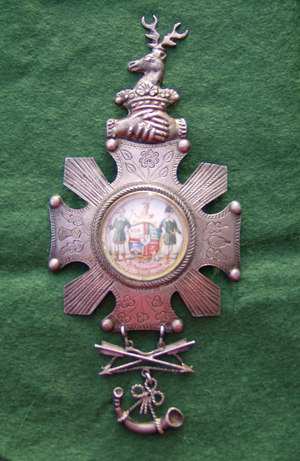 |
Silver Medal 1852 The recipient of this medal, Bro H Saunders is not one whose efforts are otherwise known to be recorded in the annals of history. Here, however, from the inscription of the reverse of this medal, is lasting recognition of his endeavours in connection with the AOF. In full the inscription reads ‘Presented by the Br[other]s of Court 518, for his services as CR [Chief Ranger] August 1852.’ These services had been undertaken at a trying time for members of the AOF in the metropolis. In 1848, an attempt at declaring unilateral independence had been made by a number of London members, with the support of their Courts. This ‘Protective Committee’ had instituted an unauthorised ‘Permanent London EC’ in opposition to the official and recognised EC. Several Courts, including 518, were suspended in September 1848 for failure to pay their quarterly dues to their District, London United. Re-admitted in March 1851, the Court once again played its part in the District and the Order. The medal takes the form of many of this period, with the stag’s head on a crown, under which is a handshake. The central feature is a hand painted colour representation of the coat of arms with Forester supporters.
|
|
| Back to Top | ||
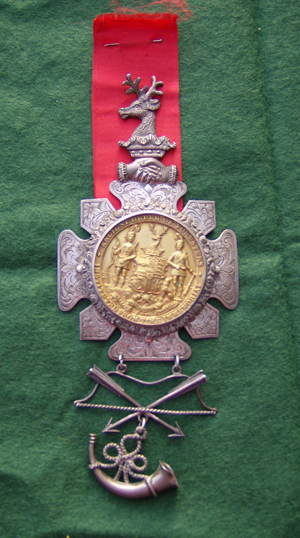 |
Silver Medal with Gold Insert - 1884 Presented to Bro. L. S. Knowler of Court “Economy”, No. 2244, of Chelsea, London, this medal bears the hallmark for London 1883, with the initials EL. The Order’s accounts for the year show E. Loewenstark of London paid £44 15s (£44.75) for supplying 35 medals. With the presentation date of the medal inscribed on the back of the medals as July 8th 1884, it seems probable this was one of the thirty five. The award was for past services as Chief Ranger. Design of medals had moved in a new direction with the introduction of the idea of a central insert, of varying qualities of gold, bearing the Order coat of arms and Supporters. On the face of the medal, around the rim, were the words ‘ANCIENT ORDER OF FORESTERS INSTITUTED FROM TIME IMMEMORIAL.’ The use of medal dies from which impressions could be taken was seen as a more secure way of the EC retaining control over the manufacture of medals. The Order Properties schedule for 1884 shows that there were 4 medal dies.
|
|
| Back to Top | ||
 |
PHCR Jewel 1911 The ultimate achievement for a member of the AOF was appointment to the position of High Chief Ranger (HCR), or national chairman. This was no sinecure, especially in the early years. Bro Edward Wright of Hull, HCR in 1841/2, ‘spent twenty six to thirty hours per week in the [Council] Chamber, up to this time to above 700 hours, and to and from the room he has travelled 1,248 miles.’ Sadly he would not have received a medal or jewel for his endeavours, as HCR jewels, of the type illustrated, were only introduced in 1895, on the authority of the Brighton, Sussex, HCM. The first PHCR to be honoured in this way was Bro. George Allbery. The ribbon colouring was the distinctive gold, green and white associated with officers at High Court level. Records suggest that it was normal for the jewel be 18 carat and bear a hallmark to confirm its origin. Bro Thomas Turner, of Burton-on-Trent, Staffordshire, was the recipient of this jewel, at the end of his year of service in 1910/11. He had had the unique experience, up to that time, of chairing two High Court Meetings, a special one having been held in to consider the National Insurance Bill in late May/early June 1911. His performance at the 1911 HCM proper at Burton on Trent in August, gained him a warm appreciation, the editorial in the Foresters’ Miscellany observing that ‘his one desire throughout the week was to give absolute fair play to every delegate.’ A worthy recipient, it seems, of a fine jewel.
|
|
| Back to Top | ||
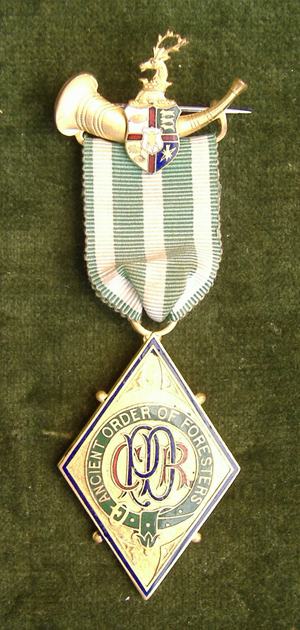 |
PDCR Jewel ‘Jewel’ as an official term came into Forestric vocabulary in October 1893 when the Cambridge EC announced that they now had in stock ‘New Foresters Jewels’. Specially manufactured by the Council by Bro. George Tutill, (the firm that is, since the original proprietor had died in 1887), the Past District Chief Ranger (PDCR) jewel came in gold, with a choice of 9 carat, 15 carat or 18 carat, or in metal, richly gilt. Prices ranged from £6 15 0 (£6.75), £4 10s (£4.50), £2 7s 6d (£2.37) or 5s (25p). The monogrammed jewel was suspended by a ribbon of green with white edging and central stripe from a richly gilt bat, in the shape of a horn, with the Arms of the Order in rich enamel. The reverse of the jewel was often incribed to record the recipients term of office, although this example remains pristine. The distinctive diamond shape may not have appealed to eligible wearers, and seems to have been discarded pretty quickly for a PDCR jewel matching the design of that devised for a Past Chief Ranger. At two and three quarter inches (7cms) long the PDCR Jewel was far less cumbersome than a silver medal with insert. PDCR Jewels were supplied in a hinged, silk lined box. Subsequently other manufacturers provided similarly designed Jewels to those originated by G Tutill. |
|
| Back to Top | ||
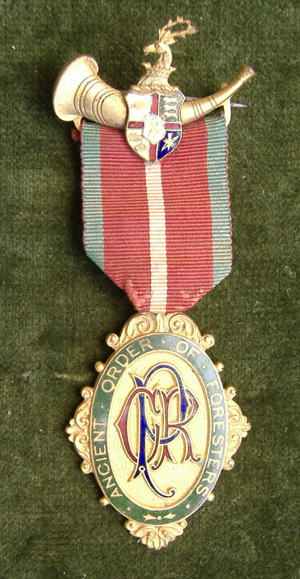 |
|
PCR Jewel At the same time that the PDCR Jewel appeared, October 1893, the Cambridge EC introduced a Past Chief Ranger (PCR) Jewel. From the richly gilt bar in the shape of a horn bearing a Shield, with the Arms of the Order, a ribbon in the colours of a PCR was suspended, whilst the Jewel itself bore the monogram PCR. Also from G Tutill, the Jewel came in a handy box. Prices for the three gold versions, in 9, 15 and 18 carats, were the same as for the PDCR jewel, however the richly gilt PCR medal was 4s 6d (22.5p). The overall design of the Jewel, ribbon and bar proved highly acceptable, and lasted for the next 100 years. Minor modification to the design of the jewel were made at different times, and in 1938 the colours on the ribbon were adjusted in line with changes to the AOF PCR neck collar. These reversed the balance between the green and purple elements. For many members the proudest moment of their Forestric involvement was receiving a PCR jewel, appropriately inscribed, at the end of their term of office. |
| Back to Top | ||
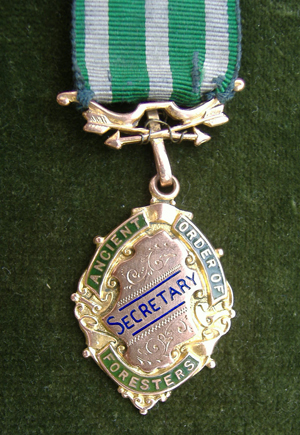 |
Court Secretary Jewel At the heart of every AOF Court was a Secretary. His or her commitment to undertaking the many and varied demanding activities associated with the requirements of administering a Court was crucial to its survival. During the late 19th century, length of service as Secretary for over 20 years was becoming increasingly common. In later years even longer service, sometimes of 50 years, was recorded. A 20th century Court Secretary who served his Court for just under 30 years was Bro. E J Shackle, of Court “St Mary’s”, No. 2313 at Tooting, south-west London. He took up office in 1913 and in 1927 received the attached Court Secretary jewel from his fellow members, ‘as a token of appreciation for services’ over that period. It is 9-carat, hallmarked with the mark of Carrington and Co, of Birmingham. The jewel is suspended by a ribbon in PDCR’s colours, and since he served in that post in the South London District in 1928/29, this may explain things. An active Court Secretary, Bro Shackle attended several High Court Meetings in the 1930’s, was on the South London District’s Panel of Auditors for many years and acted as a Book Examiner. In 1939 at the age of 68, he was Secretary of 5 Courts and Assistant Secretary to another. He died in Epsom County Hospital, Surrey, in September 1942.
|
|
| Back to Top | ||
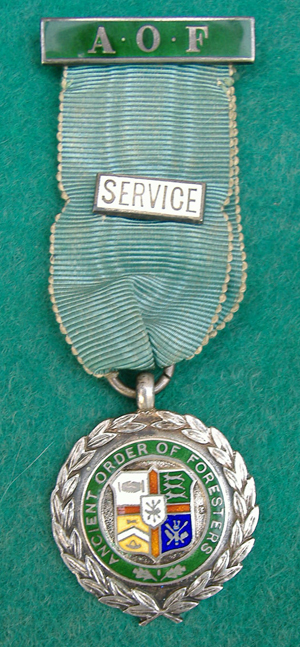 |
Silver Service Medal The proudly worn AOF silver Service medal, with its plain green ribbon, suspended jewel and inscription piece was introduced in 1927, at a sale price of 12s 6d (62.5p) including case. Bringing the new medal to members attention, the EC wrote 'It is intended for use in cases where the recipient is not entitled to a PDCR's or PCR's jewel, but whose interest and work for the Order has been of a sustained and exceptional character.' One of the first recipients of such a medal was Bro W E Deadman, of the Reading High Court Reception Committee, whose jewel is illustrated here. Although emphasis was laid on the team work needed by the 28 member committee, at the end of the High Court, the specific role of certain individuals in making the week a success was singled out. Amongst these was Bro W E Deadman ‘who did his best under conditions if great difficulty in connection with the lodging arrangements.’ On the back of the medal is the inscription appreciating his services. |
|
| Back to Top |